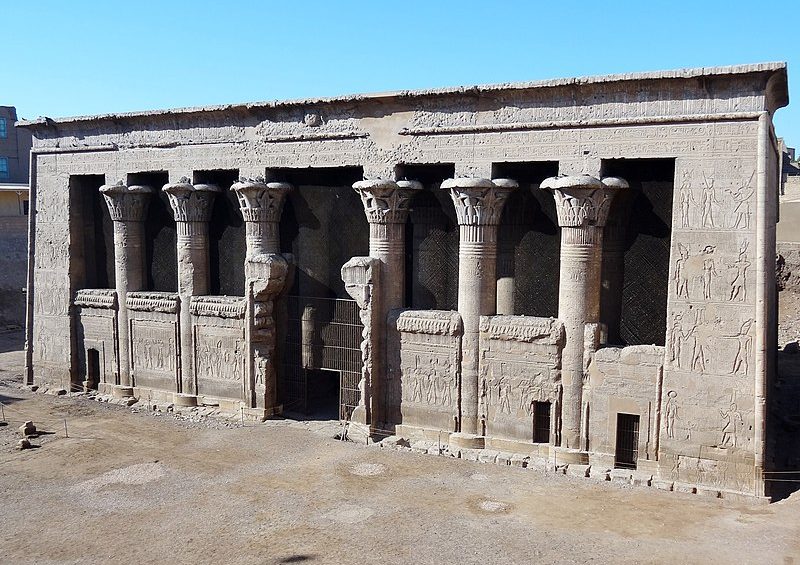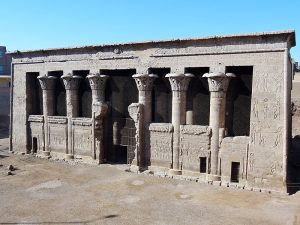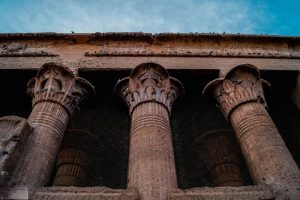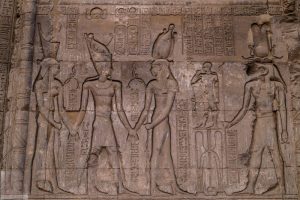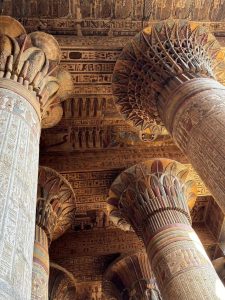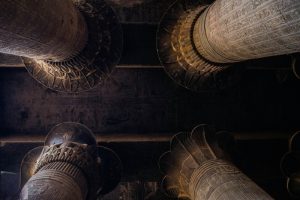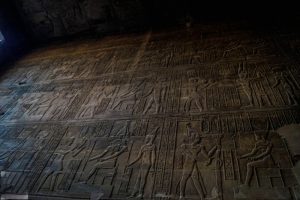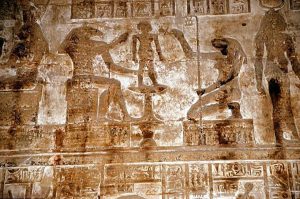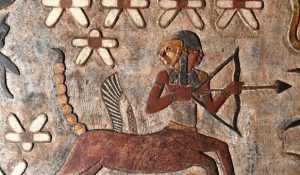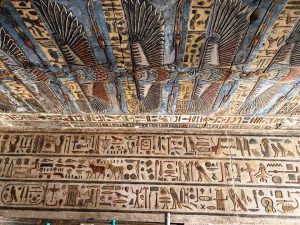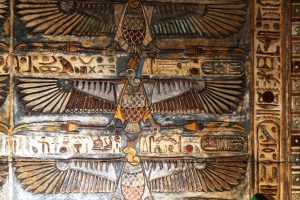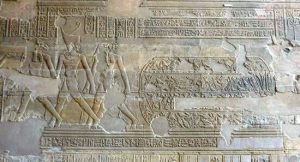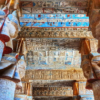Der Tempel von Esna
Der Tempel wurde 181 v. Chr. unter Ptolemäus VI. errichtet (auf den Ruinen eines altägyptischen Tempels aus der Zeit von Thutmose III.). In der römischen Ära wurde unter dem römischen Kaiser Claudius im Jahr 40 n. Chr. eine Hypostylhalle hinzugefügt. Seine Fläche beträgt 33 mal 16,5 Meter und er ist einer der schönsten Hypostylensäle Ägyptens. Der Bau und die Ausschmückung des Tempels wurden in verschiedenen Phasen bis 250 n. Chr. abgeschlossen. Während der Herrschaft von Muhammad Ali wurde der Tempel als Baumwolllager genutzt, bis er 343 n. Chr. von Schutt befreit und der Tempel entdeckt wurde. Der Tempel wurde für den Gott Khnum, seine Frau Mihit, die Göttin des Windes, und ihre Tochter Anuket errichtet.
Bild der Tempelfassade
Beschreibung des Tempels
Wie bei Tempeln der griechisch-römischen Epoche üblich, besteht der Esna-Tempel aus einer Säulenfassade mit Wandreliefs. Im Esna-Tempel zeigen diese Reliefs die römischen Kaiser Trajan, Claudius und Nero in ägyptischer Kleidung und mit ägyptischen Kronen, die den Gott Khnum verehren. Es gibt auch eine Szene der Krönung von Claudius zwischen Thoth und Horus. Wenn man durch das zentrale Tor eintritt, gelangt man in einen Hypostylussaal. An den Innenwänden sind vier Reihen von Szenen zu sehen, die die Verehrung ägyptischer Götter durch römische Könige und Kaiser darstellen, vor allem des Gottes Khnum. Die Könige werden auch dargestellt, wie sie dem Gott Khnum und seiner Frau Mihit (in Form einer Löwin) Opfer darbringen.
Bild der Tempelfassade
Römische Könige und Kaiser in pharaonischen Formen, die den Tempelgöttern Khnum, Mihit und Nebtu Opfergaben darbringen.
Die wichtigsten Innenszenen stellen die Erschaffung des Menschen, die Feste des Gottes Khnum und Szenen der Tempelgründung dar.
An der Decke des Tempels finden sich immer wieder Szenen der Göttin Nut, der Himmelsgöttin, und astronomische Szenen, die die Sternbilder darstellen.
Der architektonische Stil der Hypostylhalle
Die Hypostylushalle zeichnet sich durch das Vorhandensein von 24 Säulen aus, von denen sich 6 an der Fassade des Tempels und 18 im Inneren befinden, die in drei Reihen zu je 6 Säulen unterteilt sind. Jede Säule unterscheidet sich von der anderen in ihrer Dekoration und ihren Kapitellen, was das Genie des ägyptischen Künstlers bei der Verschmelzung von altägyptischer und griechischer Kunst widerspiegelt.
Die Abbildung zeigt die Vielfalt der Kapitelle in der Hypostylhalle.
Kapitelle der Hypostylhalle
Bild für die Innenwände der Hypostylhalle
Der Eingang des alten Tempels
Am Eingang des alten Tempels (von König Thutmose III.) ist eine Szene zu sehen, in der der Gott Khnum mit dem Kopf eines Widders und dem Körper eines Menschen die Sonnenscheibe betritt. Diese Szene bedeutet, dass der Gott Khnum von dem Gott Ra, dem großen Sonnengott, beschützt wird.
die alte Tempelfassade
Wir finden auch eine Szene mit König Ptolemäus in pharaonischer Gestalt und neben ihm seine Frau, Königin Kleopatra, die dem Gott Khnum Opfer darbringt. (Die wichtigste Szene des Tempels ist die Szene mit der Töpferscheibe. In ihr sehen wir die Funktion des Gottes Khnum als Schöpfer der Menschen aus Ton auf der Töpferscheibe, denn er erschafft die Menschen immer in der Form einer Person zusammen mit ihrem geistigen Doppelgänger)
Der Gott Khnum formt das Kind auf der Töpferscheibe.
Jüngste Entdeckungen
Kürzlich wurden Szenen des Tierkreises (die zwölf astrologischen Zeichen) entdeckt, sowie Bilder, die einige Planeten wie den Mars darstellen. Es gibt auch Abbildungen einiger Sterne, die die Ägypter zur Bestimmung der Uhrzeit kannten.
Bilder, die einige Planeten darstellen
Szenen von Inschriften, deren Farben nach der Restaurierung auftauchten, zeigen Bilder von der Gründung des Tempels und den Ritualen der Göttin Nut, der Göttin des Himmels, und ein Bild des Gottes Nekhbet.
Szenen von Inschriften, deren Farben nach der Restaurierung auftauchten, zeigen Bilder von der Gründung des Tempels und den Ritualen der Göttin Nut, der Göttin des Himmels, und ein Bild des Gottes Nekhbet.
Szenen von Inschriften, deren Farben nach der Restaurierung auftauchten, zeigen Bilder von der Gründung des Tempels und den Ritualen der Göttin Nut, der Göttin des Himmels, und ein Bild des Gottes Nekhbet.
Szenen, die Kaiser Titus in königlicher Kleidung in seinem Palast zeigen, wobei er vier Symbole der Götter Khnum, Thoth, Horus und Anubis trägt.

